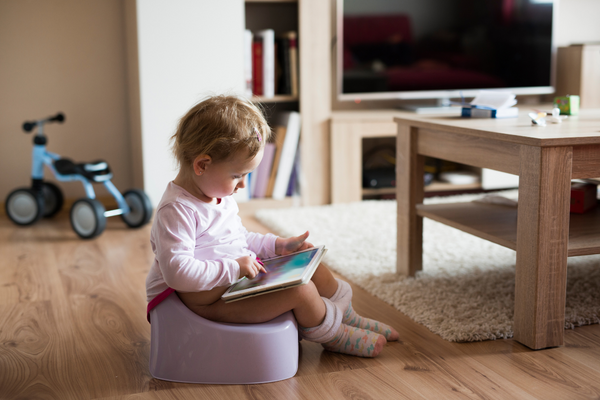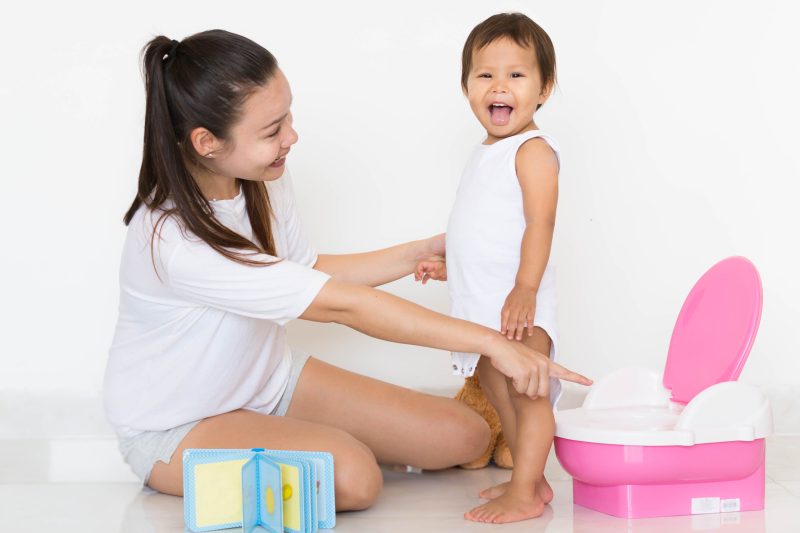Potty training strikes fear into the hearts of many parents, but it doesn’t have to be an overwhelming or daunting process.
If you hop on to Google, you will be bombarded with potty training guides and methods that can make you feel like a failure before you even begin. Potty training is a big milestone, so going into the process feeling anxious isn’t a good thing.
Here are some hints and tips that will hopefully offer support and inspiration as you begin the potty training journey with your child.
Disclaimer: This blog post contains affiliate links . If you use them, we might be rewarded credit or a commission of the sale. Please note that we only recommend tools that we personally use and love and we always have our readers’ best interest at heart.
15 Do’s and Don’ts for your Potty Training Journey
#1 DO Introduce the Concept Early
Start talking to your toddler about using the potty early on. You can have a potty in your home that they can play with and involve them in your bathroom trips because, let’s face it, they are in there with you anyway.
Help your child understand that using the toilet is a normal part of life and that most people don’t wear diapers.
#2 DO Take Your Child’s Lead
Let your child guide the process and only start potty training when they show signs of being ready.
They may start taking off their dirty diaper or showing more interest when you visit the bathroom. It’s important to remember that potty training is about your child and not about you, so you need to work with their timeline.
#3 DO Make it Fun
Potty training has such negative connotations, but really it’s an exciting process which you can make fun.
It is a sign that your child is growing up and becoming more independent. We should be embracing the aspects of motherhood that give us more time and freedom.
Use potty charts, stickers, rewards, songs, and books to make potty training a fun experience based on connection rather than anxiety.

#4 DO Be Prepared for Anything
Always have backup clothes on hand because you never know when an accident will happen. Stock up on laundry detergent and wet wipes so you are never caught unprepared.
#5 DO Get Everyone On Board
Make sure that friends, family, and teachers know you are starting potty training. Supportive people can make the process much easier and help your child feel more comfortable.
#6 DO Have a Little Patience (or a lot)
You will need a bucket load of patience as you and your child learn how best to work together and communicate through this process.
It’s easy to snap and get frustrated when you have a million other things to do and your child spends a long time sitting on the potty. But remember, a little bit of patience will go a long way in helping your child feel at ease and be more comfortable using the toilet.
#7 DO Involve your Child
Get your child involved and excited about potty training by letting them choose their own potty and big kid underwear.
Let them help you with the laundry if they’ve had an accident so they can begin taking ownership of their potty training journey.
#8 DO What Works for your Family
What works for your friend and her child might not work for you and your child, and that’s ok. You need to develop a potty training plan that suits your family, lifestyle, and your child’s personality.

#9 DON’T Expect Miracles
Don’t expect your child to get it overnight.
Potty training is a process, and no matter how wonderful you think your child is, they will potty train on their own timeline.
Some potty training methods promise success in 3 days, some in a weekend, and maybe that works for your child. But it might not so go into the process with an open mind and realistic expectations.
#10 DON’T Use Shame
Don’t use shame and punishment if your child has an accident.
We have no idea what is happening in their little brains or how stressful potty training can be for them. By letting them see your disappointment or punishing them, you are sending a damaging message that not only affects your relationship but will also set you back on your potty training journey.
#11 DON’T Start During an Unsettled Time
Don’t start potty training if you are moving house, starting daycare, going through a divorce, or experiencing any other significant life changes.
Potty training requires your child’s full attention, and everyone needs to be emotionally available to deal with the struggles of learning to use a toilet.
#12 DON’T Force It
If your child is not ready to potty train, don’t force it.
Putting too much pressure on your child can cause them to have feelings of fear and anxiety about using the toilet, which can also cause health issues like constipation.

#13 DON’T Use Only One Method
There are numerous potty training experts, programs, and methods, so don’t feel you need to get locked into one. Instead, play around with some potty training options to find the best process for your child.
#14 DON’T Talk About the Process with Others in Front of Your Child
Wouldn’t you be embarrassed if your toilet activities were discussed with other people?
Your child can experience the same feelings of shame and embarrassment when you discuss their potty training journey with other people while they are around.
#15 DON’T Compare your Child to Others
Don’t compare your child and their potty training journey to others.
Each child is unique and will experience situations in their own way. Learning to use the toilet is not a race, and you need to be conscious of your child’s experience.
Potty Training is a Personal Journey
Potty training is a personal journey for every family. You can read books, blogs, and articles and ask for advice, but in the end, you need to pick and choose the best information to help you and your child learn to potty train in a way that fosters trust and connection.




